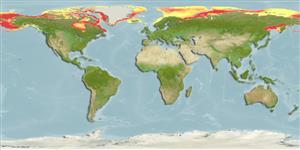>
Gadiformes (Cods) >
Gadidae (Cods and haddocks)
Etymology: Boreogadus: Greek, boreas = north wind + Latin, gadus = a fish, cod? (Ref. 45335).
Environment: milieu / climate zone / depth range / distribution range
Ekologi
laut; payau dasar (demersal); oceanodromus (Ref. 12074); kisaran kedalaman 0 - 1383 m (Ref. 58426), usually 0 - 400 m (Ref. 1371). Polar; -2°C - 8°C (Ref. 96379); 87°N - 52°N, 180°W - 180°E (Ref. 1371)
Circumpolar in the Arctic. North Atlantic: White Sea, Iceland, and southern Greenland into the Miramichi River, New Brunswick in Canada. North Pacific: Bering Sea to Cape Olyutorski, the Pribilof Islands, and Bristol Bay.
Size / Weight / umur
Maturity: Lm ? range ? - ? cm
Max length : 40.0 cm TL jantan/; (Ref. 1371); common length : 25.0 cm TL jantan/; (Ref. 1371); Umur maksimum dilaporkan: 7 Tahun (Ref. 1371)
deskripsi pendek
Kunci identifiaksi (pengenalan) | Morfologi | Morfometrik
Duri punggung (Keseluruhan (total)) : 0; duri punggung lunak (Keseluruhan (total)) : 42 - 57; Duri dubur: 0; Sirip dubur lunak: 33 - 44; vertebrata, bertulang belakang: 49 - 57. Caudal fin deeply concave. Lower jaw slightly longer than upper jaw. Chin barbel very small. No lateral line pores on head. Scales small and embedded, not overlapping. Brownish along the back with many fine points; the sides and belly silvery; the fins dusky with pale margins (Ref. 1371).
Occurs in coastal habitats during summer and winter (Ref. 1371). Cryopelagic or epontic, from surface down to 1383 m (Ref. 58426). In the Beaufort Sea, it may also be found in brackish lagoons and in almost fresh water in river mouths (Ref. 1371). Although associated with the occurrence of ice (White Sea), it is present in ice-free near-shore waters (Alaska) (Ref. 1371). Onshore-offshore movements are associated with spawning and movements of the ice (Ref. 27547). Feeds mostly on epibenthic mysids, also amphipods, copepods and fishes (Ref. 1371). Also caught with mid-water trawls (Ref. 1371). Utilized as fishmeal and source of oil (Ref. 1371). Euryhaline and eurythermic.
Oviparous, sexes are separate (Ref. 101194). Fish move close inshore, often in large numbers to spawn (Ref. 27547).
Cohen, D.M., T. Inada, T. Iwamoto and N. Scialabba, 1990. FAO species catalogue. Vol. 10. Gadiform fishes of the world (Order Gadiformes). An annotated and illustrated catalogue of cods, hakes, grenadiers and other gadiform fishes known to date. FAO Fish. Synop. 125(10). Rome: FAO. 442 p. (Ref. 1371)
Status IUCN Red List (Ref. 130435: Version 2024-1)
ancaman kepada manusia
Harmless
penggunaan manusia
Perikanan: bernilai komersial tinggi
Alat, peralatan
laporan khas
muat turun XML
Sumber internet
Estimates based on models
Preferred temperature (Ref.
123201): -1.3 - 4, mean 0.2 °C (based on 1585 cells).
Phylogenetic diversity index (Ref.
82804): PD
50 = 1.0000 [Uniqueness, from 0.5 = low to 2.0 = high].
Bayesian length-weight: a=0.00457 (0.00357 - 0.00585), b=3.16 (3.09 - 3.23), in cm total length, based on LWR estimates for this species (Ref.
93245).
Trophic level (Ref.
69278): 3.1 ±0.1 se; based on diet studies.
Generation time: 4.9 (2.6 - 5.8) years. Estimated as median ln(3)/K based on 11
growth studies.
Daya lenting (Ref.
120179): sedang, Waktu penggandaan populasi minimum 1.4 - 4.4 tahun (K=0.22; tm=2-5; Fec=30,000).
Prior r = 0.28, 95% CL = 0.19 - 0.43, Based on 2 data-limited stock assessments.
Fishing Vulnerability (Ref.
59153): Moderate to high vulnerability (46 of 100).
Climate Vulnerability (Ref.
125649): Moderate vulnerability (40 of 100).
Nutrients (Ref.
124155): Calcium = 29.7 [14.9, 76.5] mg/100g; Iron = 0.406 [0.197, 0.920] mg/100g; Protein = 16.6 [15.0, 18.1] %; Omega3 = 0.269 [0.118, 0.607] g/100g; Selenium = 21.3 [7.3, 51.3] μg/100g; VitaminA = 9.34 [1.69, 52.12] μg/100g; Zinc = 0.575 [0.351, 0.941] mg/100g (wet weight);
